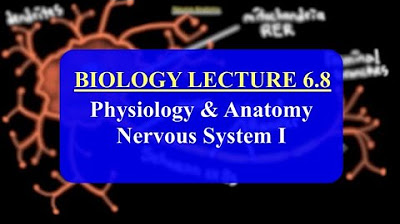Organizzazione del Sistema Nervoso | NEUROSCIENZE - Lezione 9
Summary
TLDRThis educational video script delves into the human nervous system, dividing it into the central and peripheral nervous systems. The central nervous system, comprising the brain and spinal cord, is responsible for processing cognitive functions, motor functions, and sensory systems, as well as maintaining homeostasis and hormone release. The peripheral nervous system, made up of cranial and spinal nerves, transmits signals between the brain and the body's peripheral parts. It is further divided into the sensory system, which receives stimuli from the environment and internal body, and the motor system, which controls voluntary and involuntary muscle movements. The autonomic nervous system, a key part of the motor system, is responsible for involuntary actions and is divided into the sympathetic and parasympathetic systems, working antagonistically to manage the body's stress responses and energy conservation.
Takeaways
- 🧠 The human nervous system is divided into the central nervous system (CNS) and the peripheral nervous system (PNS).
- 💡 The CNS consists of the brain and the spinal cord, located within the cranial and vertebral columns respectively.
- 🧠 The brain is the central hub for cognitive functions, motor control, and sensory integration, while the spinal cord facilitates communication between the brain and the rest of the body.
- 🌐 The PNS is made up of nerves that connect the CNS to the rest of the body, allowing for the transmission of signals from the environment and internal body to the brain.
- 🔍 The nervous system can be further divided into sensory and motor components, with the sensory system receiving stimuli from the environment and the motor system responding to these stimuli.
- 🏃♂️ The motor system is divided into the somatic motor system, controlling voluntary muscle movements, and the autonomic nervous system, which regulates involuntary functions.
- 🤖 The autonomic nervous system is further split into the sympathetic and parasympathetic systems, which have antagonistic roles in preparing the body for action or relaxation.
- 🛡️ The sympathetic system prepares the body for 'fight or flight' responses during stress, while the parasympathetic system is involved in rest and digestion, promoting energy recovery.
- 📚 The content covered in the script is typically found in high school textbooks, particularly in the fourth year of Italian high schools.
- 📖 For those seeking a deeper understanding, the script suggests consulting university-level books, which are more comprehensive but also more complex.
- 👨🏫 The speaker is a teacher who creates content to help students deepen their understanding of topics that may not be fully explored in school curriculums.
Q & A
What is the main topic of the lesson?
-The main topic of the lesson is the organization of the human nervous system.
How can the nervous system be divided?
-The nervous system can be divided into the central nervous system (CNS) and the peripheral nervous system (PNS).
What are the components of the central nervous system?
-The central nervous system is composed of the brain (encephalon) and the spinal cord.
What are the primary functions of the brain?
-The brain is responsible for the integration and processing of cognitive functions, motor functions, sensory systems, and the mechanisms of homeostasis, including the release of fundamental hormones.
What is the role of the spinal cord in the nervous system?
-The spinal cord allows communication between the brain and the rest of the body through spinal nerves, transmitting information to and from the brain.
How is the peripheral nervous system connected to the central nervous system?
-The peripheral nervous system is connected to the central nervous system through cranial nerves that originate from the brain and spinal nerves that originate from the spinal cord.
What are the two subcategories of the peripheral nervous system?
-The peripheral nervous system is divided into the sensory system and the motor system.
What is the function of the sensory system?
-The sensory system is responsible for receiving stimuli from the environment or from within the body and transmitting this information to the central nervous system for processing.
How does the autonomic nervous system function?
-The autonomic nervous system controls involuntary functions, such as the muscles of internal organs and glands, and is divided into the sympathetic and parasympathetic systems, which work together to prepare the body for action or relaxation.
What is the sympathetic nervous system responsible for?
-The sympathetic nervous system prepares the body for action in response to stress or danger, often referred to as the 'fight or flight' response.
What is the parasympathetic nervous system responsible for?
-The parasympathetic nervous system is responsible for relaxation and recovery activities, including digestion, and is active during restful periods of the day.
Outlines

Esta sección está disponible solo para usuarios con suscripción. Por favor, mejora tu plan para acceder a esta parte.
Mejorar ahoraMindmap

Esta sección está disponible solo para usuarios con suscripción. Por favor, mejora tu plan para acceder a esta parte.
Mejorar ahoraKeywords

Esta sección está disponible solo para usuarios con suscripción. Por favor, mejora tu plan para acceder a esta parte.
Mejorar ahoraHighlights

Esta sección está disponible solo para usuarios con suscripción. Por favor, mejora tu plan para acceder a esta parte.
Mejorar ahoraTranscripts

Esta sección está disponible solo para usuarios con suscripción. Por favor, mejora tu plan para acceder a esta parte.
Mejorar ahoraVer Más Videos Relacionados

Sistem Saraf Pada Manusia| Sistem Koordinasi part 1 - Biologi

As grandes vias aferentes e eferentes: Introdução e vias aferentes - Parte 1

Anatomi Sistem Saraf: Saraf Pusat & Tepi | Neurologi

Types of Tissue Part 4: Nervous Tissue

DIVISÕES DO SISTEMA NERVOSO | MK Fisiologia

IMAT Biology Lesson 6.8 | Anatomy and Physiology | Nervous System I
5.0 / 5 (0 votes)
